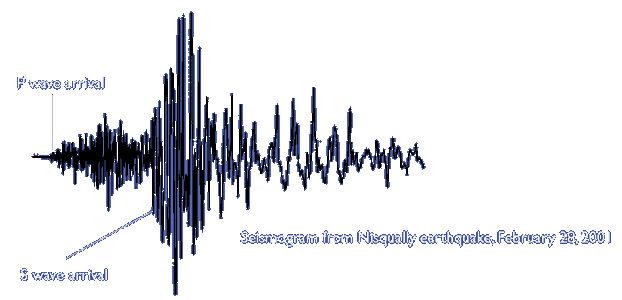About Earthquake Waves
Earthquakes make waves that travel through rock.
It is these waves that shake the surface and cause the damage.
Earthquakes make waves
As you bend a stick, energy (strain) builds up until the stick
breaks and the energy is released. This is similar to what happens
in an earthquake.

|
In the earth, rocks bend and then they break. The break is
called a fault. The break generates waves of energy that spread
out in three dimensions, like sound waves. These earthquake
waves are called seismic waves. The larger the earthquake,
the bigger the waves.
An earthquakes focus is the place where energy is released.
|
 |
Waves travel at different speeds
An earthquake creates different kinds of waves. These different
waves travel at different speeds. The primary wave (P wave) travels
the fastest through the earth. The motion is like movement along
a spring waves of compression and expansion. We feel the primary
wave as the first THUD! of an earthquake.

The secondary wave (S wave) travels more slowly through the earth.
Its snaky motion is like a shaken rope. We feel it as a lot of quaking.

Other waves travel along the ground surface. They are even slower,
but they are highly destructive. When they arrive, we feel like
were riding a rollercoaster.

Why measure waves?
Seismographs are the instruments that record earthquake waves.
A seismogram is the record of an earthquake. This seismogram records
the 2001 Nisqually earthquake. The first jog shows the arrival of
the P wave at the recording station. The slower S waves arrive a
little later. Because we know the different speeds of P and S waves,
we can figure out where an earthquake happened. We also can calculate
earthquake size, called magnitude.

How big is it?
The magnitude of an earthquakethe amount of energy releasedis
usually expressed as a number. Magnitude 2 is the smallest we can
feel, and magnitude 9.5 is the largest ever measured. Each step
on the scale is ten times greater magnitude than the step before.
For example, a magnitude 8 quake is 10 times greater than a magnitude
7, and 100 times greater than a magnitude 6. The Richter Scale is
one type of magnitude scale.
Another way of measuring an earthquake is by its intensityhow
much shaking people feel and how much damage is done. Intensity
is measured on the 12-point Mercalli scale. Nowadays, scientists
are developing instruments that can measure intensity directly.
Each earthquake has a single magnitude, but the intensity of its
effects varies from place to place.
Next Page
|

